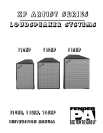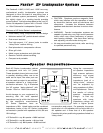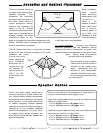
wwwwww..ffeennddeerr..ccoomm
3
wwwwww..mmrrggeeaarrhheeaadd..nneett
There are several things to
consider when placing loud-
speaker cabinets. First
determine the horizontal
coverage requirements for
the room. When used in a
typical auditorium setting,
position the speakers as
shown in Fig. B. Ensure
adequate sound levels reach
each seat in the audience by
walking through the entire
auditorium—listen for any
gaps in coverage then reposition speakers as nec-
essary. Recheck sound coverage with a full audi-
ence in attendance, if possible.
The XP Series horn has a horizontal coverage
angle of 70º and a vertical coverage of 35º; bass
speakers are nearly
omnidirectional.
When setting up
your XP Series
enclosures as a
“single unit,” aim
the cabinets 70°
apart as shown in
FIG. C, for 140°
of horizontal cov-
erage.
Other considera-
tions include
bass frequency
performance and
feedback...
When a XP
speaker is placed
near a wall, there
will a low-fre-
quency boost of
up to 3dB. The
drawback is that
close proximity to
a wall may also cause feedback.
To avoid feedback: Increase the distance
between speakers and the feedback source
whether it is a wall, a microphone, or a guitar. Use
cardioid–pattern microphones to help block feed-
back. Always keep microphones
pointed away from speakers.
Sound quality is often compro-
mised when a sound system is
required to be hidden from
sight. Remember that the
location of your loudspeaker
cabinets will affect sound qual-
ity and coverage area more than
any other factor.
Power and audio signal cables are a
common sources of sound system fail-
ure. Quality cables, carefully maintained,
are essential to the reliability of the entire
sound system. Long cable connections
or cables supplying multiple speaker
cabinets must be of a sufficient gauge to
transfer all of the available amplifier
power to the speakers. As a rule, thick-
er cables (lower gauge numbers) are
more efficient because they absorb less
power themselves.
Prevent power loss and the degradation of signal quality by
using the recommended cable gauges below.
Cable that suppplys one cabinet, such as the cable to the last
cabinet in a “daisy-chain”:
• Up to 50-feet requires 18-gauge cable
• Up to 100-feet requires 16-gauge cable
Cable that suppplys two cabinets, such as the cable from the
amp to the first cabinet in a “daisy-chain”:
• Up to 25-feet requires 18-gauge cable
• Up to 50-feet requires 16-gauge cable
• Up to 100-feet requires 14-gauge cable
SS
SS
pp
pp
ee
ee
aa
aa
kk
kk
ee
ee
rr
rr
CC
CC
aa
aa
bb
bb
ll
ll
ee
ee
ss
ss
AA
AA
cc
cc
oo
oo
uu
uu
ss
ss
tt
tt
ii
ii
cc
cc
ss
ss
aa
aa
nn
nn
dd
dd
CC
CC
aa
aa
bb
bb
ii
ii
nn
nn
ee
ee
tt
tt
PP
PP
ll
ll
aa
aa
cc
cc
ee
ee
mm
mm
ee
ee
nn
nn
tt
tt
Stage
70°
70°
Audience
FIG. B
XP
XP
1
4
0
˚
o
f
H
o
r
i
z
o
n
t
a
l
C
o
v
e
r
a
g
e
70°
FIG. C
XP
XP






